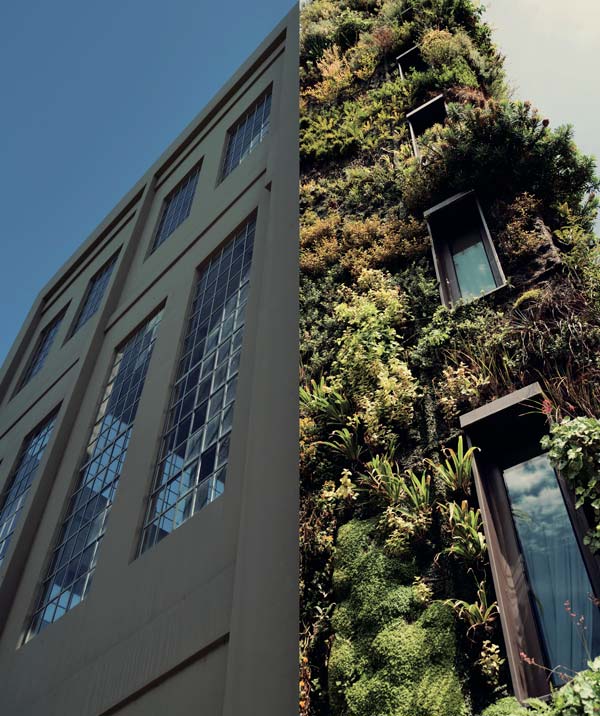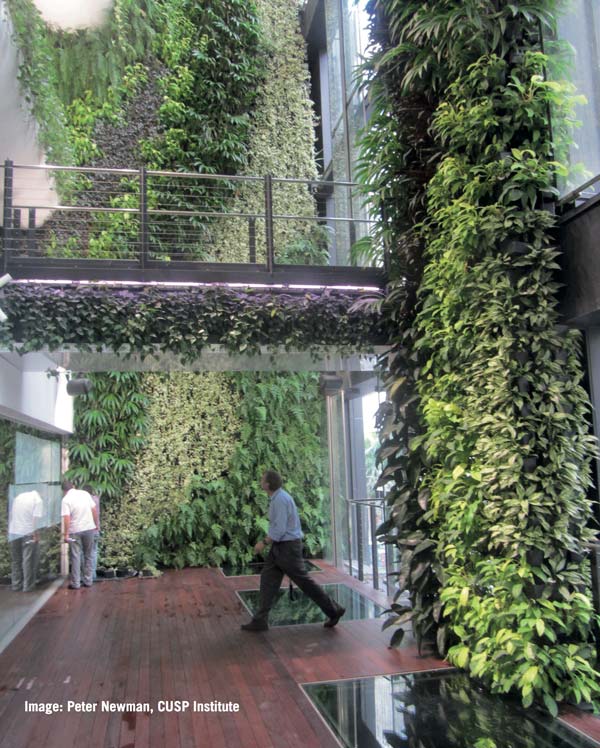Biophilic urban design represents a timely convergence of technologies, research, understanding and desire. With climate change and peak oil driving cities to increase density, the inclusion of nature in our cities has been receiving a renewed focus. The recent expression of this is called biophilic urban design or biophilic urbanism.
Biophilic urban design goes beyond the incorporation of nature into the spaces between our buildings; it is about including nature into the very design of our buildings through direct greenery, patterning, places of sanctuary and prospect plus the use of organic forms and materials. Traditionally, use of local materials plus the themes and patterns of nature connecting to culture and heritage have created some of the most beautiful buildings in the world. It was the way our cities were designed for much of human history and globally there is a rapidly expanding movement to create more satisfying and fulfilling modern societies in harmony with nature.
A global paradigm shift in how we build and design our cities is occurring with biophillic urban design an intrinsic component.
 THE SOCIAL BENEFITS
THE SOCIAL BENEFITS
– Stress reduction/ increased well-being
– Aesthetic responses
– Decreased violence and crime
– Increased productivity and cognition
– Increased liveability in high densities
– Increased community engagement
– Increased food security
Studies have shown that exposure to nature reduces heart rate variability and pulse rates, decreases blood pressure, lowers cortisol and increases parasympathetic nervous system activity whilst decreasing sympathetic nervous system activity (Li et al., 2011; Matsunaga, Park, Kobayashi, & Miyazaki, 2011; Park, Tsunetsugu, Kasetani, Kagawa, & Miyazaki, 2010; Tyrväinen et al., 2014). These responses contribute to improvements in cognitive functioning, working memory and learning rates and can also be triggered by indoor pot plants or even viewing pictures of nature (Berman, Jonides, & Kaplan, 2008; Berto, 2005; Raanaas, Evensen, Rich, Sjøstrøm, & Patil, 2011). Nieuwenhuis, Knight, Postmes and Haslam (2014), noticing two opposing trends in of ces, conducted studies of the comparison: lean vs. green. They concluded that lean is “meaner than green”, not only because it was less pleasing to the workers but also because organisational output and productivity was significantly less in the lean offices.
Increasing greenery in housing estates resulted in less violence and aggression, less crime and better interpersonal relationships (Kuo & Sullivan, 2001). Studies by Guègan and Stefan observed thatshort immersions in nature elicited a more positive mood and a greater desire to help others (Guéguen & Stefan, 2014). Conversely to this, Salingaros and Masden suggest that “Environments devoid of neurologically nourishing information mimic signs of human pathology. Drab minimalist surfaces reproduce symptoms of strokes and macular degeneration, for example” (Salingaros & Masden, 2008, p. 69).
Park and Mattson found that indoor plants in hospitals “enhance patients’ physiological responses, with lower ratings of pain, anxiety and fatigue, and more positive feelings and higher satisfaction with their hospital rooms” (Park and Mattson, 2008). A study in Michigan revealed a 24% less frequency of health care visits for prison residents with views of nature (Moore, 1981). Measurements of elderly women exposed to a green rooftop forest on a hospital showed that they were more physiologically relaxed and restored (Matsunaga, Park, Kobayashi &Miyazaki, 2011).
Self-replicating patterns that occur at increasingly smaller magnification are found throughout nature and are known as
fractal patterns. Although seen throughout architecture and art and intuitively appreciated, it is only recently that measurement of the psychological and physiological responses to fractal patterns has occurred (Biederman & Vessel, 2006; Ode, Hagerhall, & Sang, 2010; Stamps, 2002; Taylor, 2006). Viewing nature, especially the richer patterns, has been found to literally be pleasurable due to the stimulation of the mu-opiod receptors in our brain and greater endorphin release (Biederman and Vessel 2006).
It was found that certain fractal dimensions trigger more intense physiological responses, with many of these responses indicative of stress reduction (Taylor, 2006). Taylor suggests how incorporating a rich variety of fractal patterns into buildings can be useful in situations where “people are deprived of nature’s fractals” (2006).
 THE ENVIRONMENTAL BENEFITS
THE ENVIRONMENTAL BENEFITS
– Water management
– Urban heat island/climate change
– Biodiversity
– Air pollution/phytoremediation
– Reduced energy consumption
– Carbon reduction
– Noise reduction
CARBON REDUCTION
Greater green foliage in our cities would assist in airborne carbon reduction through photosynthesis and carbon sequestration in the roots and stems (Akbari, 2002; Leung et al., 2011; Sheweka and Magdy 2011). This can be achieved through green roofs, living vertical walls and urban trees. Carbon reduction also occurs through reduced energy consumption associated with the use of insulating green roof and walls.
URBAN HEAT ISLAND EFFECT REDUCTION AND REDUCED ENERGY CONSUMPTION
The appropriate use of vegetation in the built environment can adjust the urban microclimate and improve thermal behaviour of building envelopes (Kontoleon & Eumorfopoulou, 2010). Studies done with models suggest that vegetated facades can reduce the effect urban heat island around 2 degrees Celsius, improving air quality, thermal comfort and health human, with savings in electricity consumption of 5% to 10% (Sheweka & Mohamed, 2012; Susca, Gaffin & Dell’Osso, 2010). Vegetated facades reduce interior temperatures and delay solar heat transfer, leading to reductions in energy consumption used in air conditioning (Cheng, Cheung & Chu, 2010).
Green roofs are capable of reducing the use of energy for cooling and heating (Susca, Gaf n & Dell’Osso, 2010). French studies concluded that a green roof reduced summer indoor air temperatures by 2 degrees with the annual energy demand reduced by 6 per cent (Jaffal, Ouldboukhitine & Belarbi, 2012). Hong Kong research revealed a maximum temperature decrease of 8.4 degrees if both green walls and green roofs are used to create a green urban canyon. City wide this could reduce energy needed to cool buildings by between 32% and 100% (Hongming & Jim, 2010).
AIR POLLUTION AND PHYTOREMEDIATION
Phytoremediation refers to the use of plants and associated soil microbes to reduce the concentrations or toxic effects of contaminants in the environment, it is the ability of plants to ‘clean’ or remediate the surrounding air, soil or water (Carey, 2013; Pugh, MacKensie, Whyatt &Hewitt, 2012; Leung et al., 2011). Pollutants such as ozone, nitrogen oxide, sulphur dioxide, ammonia, nitric acid, carbon monoxide and particulates can be remediated by urban vegetation (Leung et al. 2011; Ottele, Van Bohemen & Fraaij, 2010). Mechanical filtration and phytoremediation could enable grey water to be used to irrigate green roofs and living walls in hot areas with little water (Carey, 2013).
Ongoing research conducted at NASA on the potential of plants to assist air purification in closed systems evolved to focus on air quality in space stations and closed-system buildings, with particular attention to the removal of formaldehyde and other volatile compounds. They concluded that plants, particularly the spider plant was effective in pollutant removal (Wolverton, McDonald & Watkins, 1984). Studies conducted in a primary school monitoring temperature, carbon dioxide, carbon monoxide, VOCs, carbonyls and particulate matter with and without plants corroborated NASA’s findings.
WATER MANAGEMENT
With vertical green facades gravity encourages water to ow through the plants growing medium and, depending on the green façade system can act as a biofilter for the water used. The large vertical root zone typical of a living wall can also ef ciently purify water through phytoremediation processes of phytofiltration and rhizofiltration (Burrows & Corragio, 2011).
Green roofs are used to lessen storm water runoff, particularly in the US. This reduces the overall amount of pollutants entering water ways (Gregoire & Clausen, 2011).
BIODIVERSITY
With declining biodiversity, increasing habitat in our cities through increased urban vegetation is receiving focus in many countries. Green roofs, with the appropriate plant species selection, have
the potential to mitigate ‘the loss of ecosystem services in urban areas’ (Cook-Patton & Bauerle, 2012; Grant, 2006). Switzerland, particularly Basel, have been studying the progression of biodiversity associated with their green roofs with encouraging results (Brenneisan, 2006). Some bird species are beginning to colonise the Swiss green roofs (Baumann, 2006). France, in a study of 115 ‘wild colonised’ green roofs in urban northern cites, found that 86 percent of the colonies were native plants (Madre, Vergnes, Machon & Clergeau, 2014).
Economic Benefits
The social and environmental benefits combine to contribute to significant economic benefits. The research has provided the quantifiable data that has enabled the economic case to be made.
› Increased property value
› Increased retail sales (up 25%, Wolf 2005)
› Decreased energy consumption
› Decreased violence and crime
› Extended building life
› Increased liveability- enabling higher density and reduced footprint
› Decreased water management costs
› Increased cognition, increased productivity
› Decreased absenteeism, increased presenteeism
› Increased healing rates and health
› Food security

